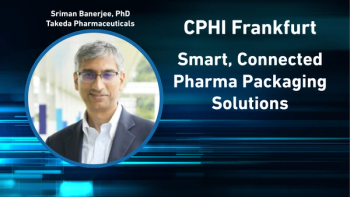
Equipment and Processing Report
- Equipment and Processing Report-05-10-2017
- Volume 10
- Issue 6
Packaging Innovations Protect Pharma Products
At INTERPHEX 2017, exhibitors displayed packaging innovations designed to improve quality, security, and patient protection.
Drug packaging plays a crucial role in protecting patients. At INTERPHEX 2017, companies highlighted stringent quality systems, solutions for complying with the Falsified Medicines Directive, and improved blister packaging.
Italy-based Capsulit, a first-time exhibitor at INTERPHEX, imprints all standard sizes of flip-off caps, 13-, 20-, 28-, and 32-mm diameters (see Figure 1). Potential messages include safety alerts and product information.
Datwyler, a Switzerland-based supplier of elastomer components, introduced a product-centric, three-category business structure at INTERPHEX 2017: Bio Care (large molecule drugs), Pharma Care (small molecule drugs), and Med Care (medical products). The company also is expanding its position in the US market with construction of a plant in Middletown, DE, not far from its existing plant in Pennsauken, NJ. The Delaware facility, which represents an investment of more than $100 million, will run in accordance to the company’s First Line production standard, which exceeds the most stringent quality standards of European and US regulatory authorities and is certified to ISO 15378. Already in place at its plant in Belgium, Datwyler’s First Line standard relies on ultra-modern cleanroom technology, automated production cells, 100% camera inspection, and a validated washing process to produce products with extremely low levels of particulates, bioburden, and endotoxins. Production is scheduled to begin in 2018.
Product protection
The StellaGUARD security label from Covectra embeds holographic stars in the substrate to deter counterfeiting and diversion and meet requirements of the European Union’s 2019 Falsified Medicines Directive, which requires tamper-evident seals on all primary packages for pharmaceutical products. The random pattern of stars and a serialized GS1 2D barcode enable real-time authentication and serialized pedigree tracking through the use of a mobile app developed by Covectra. On the packaging line, an image of the 2D barcode and StellaGuard pattern on each label is captured and stored in the Cloud. To authenticate product, the label is scanned with an iPhone and an image is captured and compared with the production line image. No special scanner is needed, and results are returned in a couple seconds. Scans also can generate marketing messages, coupons, and other interactions with the consumer. Scan reports show expiration date, number of scans, and GPS data and can provide alerts if one code is scanned too often, indicating possible duplication by a counterfeiter. An Android version of the mobile app will be available before the end of 2017.
Another option that provides compliance with the Falsified Medicines Directive, a security booklet label from Schreiner MediPharm, combines a seal with security features such as a unique 15-digit KeySecure code in 2D barcode or human-readable format, a BitSecure pattern, which won’t scan if copied, and a radio frequency identification chip. Authentication can be accomplished by entering the code on the manufacturer’s website, a mobile query of the 2D code via SmartPhone, calling a hotline, or by scanning the RFID chip with an Android-based NFC-equipped SmartPhone. The phone’s contact-less scan of the chip also could take the user to a website or provide other information such as usage instructions. “There’s interest for biologics, especially self-administered products, because the information is always available [on the phone],” Glen Dul, president, Schreiner Medipharm, told Pharmaceutical Technology.
A specialized feeder, pick-and-place action, thermoformed web, and Scanware inspection system on the FA1 machine from Pharmaworks streamline bulk tablet inspection. The clear web allows the top and bottom of each tablet to be inspected. Configured with up to nine lanes, the unit can check up to one million tablets per hour (see Figure 2).
To make it harder to overlook and accidentally ingest desiccant canisters, Clariant Healthcare Packaging has developed red, custom-printed labels (see Figure 3). The colorful labels not only differentiate the canisters, but also enhance brand identity. Labels feature an easy-to-understand pictogram and the words “Do Not Eat” in multiple languages. An outer varnish coating ensures ink is not in direct contact with the drug. The highly visible canisters serve as a drop-in replacement for traditional desiccant canisters.
Blister packaging
For blister packaging, the serialization-ready Digiline Blister printer from Atlantic Zeiser prints variable information on blister foil (see Figure 4). Clear, crisp alphanumerics can be reproduced in font sizes as small as 4-point. UV curing protects print from scuffing and other damage.
RBP Bauer, which is represented in the United States by Prodieco, has designed the CP50 deblistering machine for the US market. Designed for paper-backed blisters, the system diecuts each blister to recover the solid dose at a rate of 50 blisters per minute. Push-through lidstock (without a paper layer) can be handled even faster at 60 blisters per minute.
Articles in this issue
over 8 years ago
Modernizing Organic and Elemental Impurities Standardsover 8 years ago
Optimizing Yields on Modern Tablet Pressesover 8 years ago
Understanding How Excipients Affect Drug QualityNewsletter
Get the essential updates shaping the future of pharma manufacturing and compliance—subscribe today to Pharmaceutical Technology and never miss a breakthrough.



